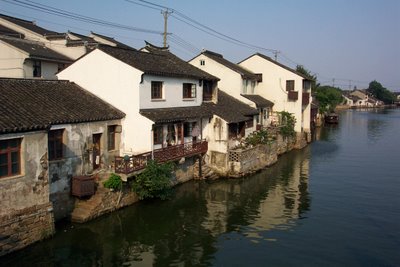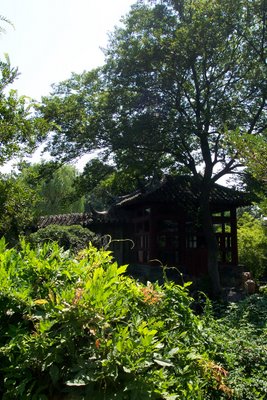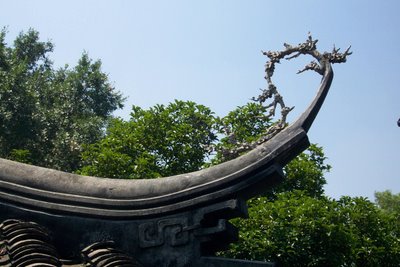Suzhou is a little city/town about 100 km west of Shanghai. It is known as the "Garden City, Venice of the East" due to its systems of canals and water ways. It contains more than 100 gardens (big and small). It also has a reputation as having the most beautiful women in China. There is a famous Chinese proverb about the city (and another city): "In heaven there is paradise, on earth Suzhou and Hangzhou".
 I actually managed to get myself up early enough to head for the train station. I was there by around 7:30. When I got out of my taxi at the underground drop off, there was a guy standing there, waiting for people to get out of taxis. He asked me where I was going, I said Suzhou. He said okay. I said I had to get a ticket. He said okay. He said it is 20 Yuan. He said I had to pay at the little booth. I was stupid enough to think that it might actually be that easy to get a ticket. I paid the money and the guy said to follow him. I said I wanted my ticket. He said to follow him. He took me to the main ticket office, where there were soooooooooo many people lined up. He said no… follow me. I followed. He then took me to the opposite end of the station, to the soft seat ticket office. I was actually there too early, as the soft seat tickets office didn’t open until 8. I guess to catch the earlier trains, I would have had to buy my tickets the day before. The guy said I had to wait… obviously. I had already decided that he had scammed me. I said I needed to get something to drink. He said he would wait there, and pointed me to a little shop. He was gone when I got back. I managed quite well without him. My ticket was 24 Yuan. I was on the 8:30 train to Suzhou.
I actually managed to get myself up early enough to head for the train station. I was there by around 7:30. When I got out of my taxi at the underground drop off, there was a guy standing there, waiting for people to get out of taxis. He asked me where I was going, I said Suzhou. He said okay. I said I had to get a ticket. He said okay. He said it is 20 Yuan. He said I had to pay at the little booth. I was stupid enough to think that it might actually be that easy to get a ticket. I paid the money and the guy said to follow him. I said I wanted my ticket. He said to follow him. He took me to the main ticket office, where there were soooooooooo many people lined up. He said no… follow me. I followed. He then took me to the opposite end of the station, to the soft seat ticket office. I was actually there too early, as the soft seat tickets office didn’t open until 8. I guess to catch the earlier trains, I would have had to buy my tickets the day before. The guy said I had to wait… obviously. I had already decided that he had scammed me. I said I needed to get something to drink. He said he would wait there, and pointed me to a little shop. He was gone when I got back. I managed quite well without him. My ticket was 24 Yuan. I was on the 8:30 train to Suzhou.The train was very nice: comfortable, fast, air-conditioned.
Once I got to Suzhou, I was trying to figure out what to do. Several people were walking around trying to get people to go on organized tours. One of them showed me pictures of the places that I could go on the tour. I said I didn’t understand Chinese. He said that was okay, that the tours were the same for Chinese or English. The price for the tour, including the entrance fees for 4 places and the transportation was 140 Yuan. The tickets alone added up to around 120, I think. Against my better judgment, I hopped on a bus. The guide spoke a little bit of English, but not much. After a very short wait, the bus was full and we were off. We stopped in front of some sort of temple or but didn’t go in. Then I was told to go to another bus, which was going to the places that I had selected (I hadn’t really selected any places, as I had no idea what the pictures were of that they guy had shown me). Once on that bus, I had to wait for about 10 minutes before they were ready to go. Once we were on our way, the tour guide was talking non-stop, in Chinese, of course.
The first stop was the Couple’s Garden or The Garden of Couple’s Retreat.
 It covers an area of about 0.8 hectares; a nice little garden. Within the garden, there are several buildings, all with different names.
It covers an area of about 0.8 hectares; a nice little garden. Within the garden, there are several buildings, all with different names.The Inkslab Returning Studio (from the information board in the room):
Xuan Zu, the owner of the garden, had his inkslab lost, which was later re-obtained by Bing Cheng, thus the studio gets the name. Laud out in the pattern of study room, the studio is an ideal place for study, and the couplet in the studio is written by Liu Yong.Thatched Cottage in the Depth of the City (from the information board in the room):
As the main building of the eastern garden, it appears lofty and spacious and is the place where the owner of the garden meets his guests. The rosewood furniture is set out in the traditional pattern of main hall and the stele was inscribed by Liang Tongshu, head of the four calligrapthers during the reign of Emporer Qiantong and Emporer Jiaqing.

 The guide talked for a while before letting everyone wander for a half hour. We were led out the back way to get onto wooden boats to be taken back to the buses.
The guide talked for a while before letting everyone wander for a half hour. We were led out the back way to get onto wooden boats to be taken back to the buses.
The next stop was the North Temple, which has the tallest pagoda south of the Yangtze River.  The pagoda is 9 stories high. I climbed to the top for the view. There is construction going on in some parts of the temple complex, so not all areas were accessible. While I was in the pagoda, I think everyone else from my bus was checking out the temple complex, so I avoided the crowds in both. There is a beautiful little garden and pond in one corner of the area, beside a teahouse/gift shop.
The pagoda is 9 stories high. I climbed to the top for the view. There is construction going on in some parts of the temple complex, so not all areas were accessible. While I was in the pagoda, I think everyone else from my bus was checking out the temple complex, so I avoided the crowds in both. There is a beautiful little garden and pond in one corner of the area, beside a teahouse/gift shop.  When I was back there, a girl from the teahouse was feeding the fish and turtles, talking to them. There were several kinds of fish in the pond. I’m not sure exactly what they all were. Some of them were huge. There were so many turtles in the mix, too.
When I was back there, a girl from the teahouse was feeding the fish and turtles, talking to them. There were several kinds of fish in the pond. I’m not sure exactly what they all were. Some of them were huge. There were so many turtles in the mix, too.
The bus then took us to the city moat where we piled onto a boat for a tour. Once again, everything was said in Chinese. I sat on the wrong side of the boat, as most of the interesting looking buildings were on the other side. Too bad. After the little boat trip, we were escorted to a silk factory. I got to see how the silk was gathered and processed. The place smelled of silkworm pupa… reminding me of many of the little snack stands on the streets in Korea. Shudder… A single strand is taken from each cocoon. Several are twisted together and then wound up onto a spool. Another method is to soak the cocoons and remove the pupa, then wash the silk and stretch it out to make the inside of a pure silk blanket/comforter/duvet. Then they tried to sell some of the blankets and other silk things. The prices were not so great, though. The same silk scarves that I had haggled down to 3 for 75 Yuan in Shanghai were priced at 80 Yuan each. Not much of a deal. Needless to say, I didn’t purchase anything, nor, I think, did anyone else.
After the little boat trip, we were escorted to a silk factory. I got to see how the silk was gathered and processed. The place smelled of silkworm pupa… reminding me of many of the little snack stands on the streets in Korea. Shudder… A single strand is taken from each cocoon. Several are twisted together and then wound up onto a spool. Another method is to soak the cocoons and remove the pupa, then wash the silk and stretch it out to make the inside of a pure silk blanket/comforter/duvet. Then they tried to sell some of the blankets and other silk things. The prices were not so great, though. The same silk scarves that I had haggled down to 3 for 75 Yuan in Shanghai were priced at 80 Yuan each. Not much of a deal. Needless to say, I didn’t purchase anything, nor, I think, did anyone else.
Then we were herded back on the bus for a very short drive (basically across the street) only to be ushered into a small room with tables and fans and a small stage. I managed to get a nice seat right in the breeze of a fan. There were more than one group there, and most people ended up having to stand. A man and woman entered the stage, each with an instrument. They played a very short song. The man sang a very short song, and then the woman sang a very short song. They both played during both. Then the stood up, took a bow and left. The whole thing lasted maybe 3 minutes. Then we all had to get up and go. All I could think was… that was strange.
Lunchtime. We were taken a short distance away for lunch. Most of the group disappeared in the building. After noticing my confusion at what to do, the guide told me to just sit down at a table and order something. With the menus all in Chinese, that wasn’t quite possible. I told her I wanted something that was not fish. She pointed at what a couple of people were eating and asked if I wanted something like that. I had no idea. Finally, she took me to the back where the dishes were being prepared. I got to choose 3 little dishes: a chicken/vegetable dish, cucumber salad, and a cabbage salad. I also got some vegetable soup and rice. The meal cost me 15 Yuan. It was actually quite tasty.
After lunch, we went to the Feng Bridge, a small foot bridge attached to an old gate/tower type structure. Another tour guide (the same company) was talking non-stop in Chinese. I asked the guide from my bus what the place was. She said she didn’t know how to explain it in English, except that it was an important bridge. That helped. She said I could wander for 30 minutes and then meet down were the little boats were. A couple that was on my bus asked me if I understood Chinese. They looked like everyone else on the bus, but they were Chinese Americans. They said they didn’t speak Chinese (they obviously did, though, as I heard them speaking to some of the other people on the bus). I asked the guy if he know what the place was. He said he didn’t know, but the gate was supposedly built during the Ming Dynasty, or something like that. Anyway, it was very old and important. I did figure out what it was thanks to an information board in the gate/tower (sorry, my photo of the info was not so clear):
I did figure out what it was thanks to an information board in the gate/tower (sorry, my photo of the info was not so clear):
The Iron Bell Pass is the historical remains of Ming Dynasty in the resistance against Japan. Int eh years under the rule of Emporer Jiaqing, Governor Shang Weichi and County Magistrate ?? supervised the construction of this strategic pass in 1557. In the ninth year of Emporer Dao ?? it was changed into a chamber of cultural star (?) which was destroyed later. In 1986, Suzhou People's Government reconstructed the pass and chamber for the tourists to visit.
One of the most interesting things there was a statue of a man in a reclined position, holding his finger out. People were going and rubbing the finger. You could tell that was the thing to do, as the finger was all nice and shiny. I, too, of course, had to get a picture with the yank my finger statue.
At the boats, we all got on one and went for another little boat ride. This time the boat was air-conditioned. We didn't actually go very far, though. A bit pointless if you ask me (I suppose if I had actually understood what was being said by they guides, it would have been a bit more worth my while).
The next stop was just as pointless, if not more so. We all shuffled upstairs in a little non-descript building where we had to find a seat around one of two rooms. We did a tea tasting: basically a thimble full of 3 different types of tea. The woman preparing the tea was, I assume, talking about the type of tea and how to properly make the tea. The room was so hot, even with the air-conditioner on in the corner. I’m not sure what one of the kinds of tea was. It was little mould-like balls/shapes. Not a bad taste, though. Then they were trying to sell different sets of tea, teapots, etc. Once again, everything was very over-priced and no one bought anything.
The last stop was just to see Dragon Hill from a distance. Dragon Hill is a man made hill – a tomb of the founder of Suzhou. On top of the hill is the Yunyan Pagoda, which is leaning about 2 meters from its original position.  To actually go into the garden, up to the pagoda, I would have had to pay to get into the park. The guide said that it really isn’t worth it, as the hill is just a plain garden with a pagoda on top. It is just as good to take pictures of it from a distance. I would have gone for it, but was already feeling tired. It was a long day already, and I was all sunned out.
To actually go into the garden, up to the pagoda, I would have had to pay to get into the park. The guide said that it really isn’t worth it, as the hill is just a plain garden with a pagoda on top. It is just as good to take pictures of it from a distance. I would have gone for it, but was already feeling tired. It was a long day already, and I was all sunned out.
The bus was back to the train station at around 5:30pm.
No comments:
Post a Comment